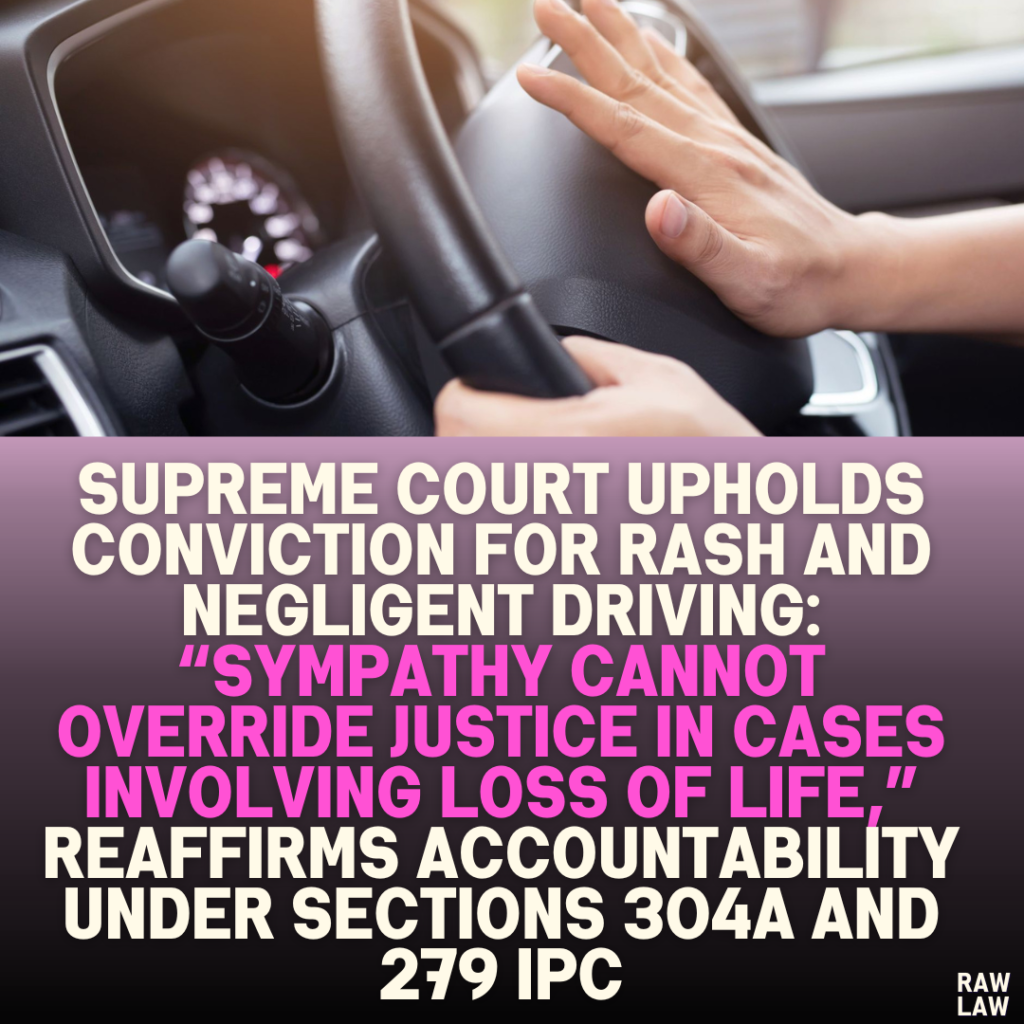Court’s Decision
The Supreme Court dismissed the appeal filed by the accused, upholding his conviction under Section 304A (causing death by negligence) and Section 279 (rash and negligent driving) of the Indian Penal Code (IPC). The Court reaffirmed the six-month simple imprisonment and a fine of ₹1,000 imposed by the trial court and upheld by the appellate court and the Karnataka High Court. In rejecting the plea for leniency, the Court emphasized that “sympathy cannot override the need for justice, particularly in cases involving loss of life.”
Facts of the Case
- Incident:
On October 18, 2009, the accused was driving his Qualis vehicle (registration number KA-01/M-3840) on NH 206 from Bhadravathi to Tarikeri at high speed and in a rash and negligent manner. He collided with a motorcycle from behind, injuring the rider, who later succumbed to his injuries, and the pillion rider, who sustained minor injuries. - Prosecution Evidence:
- The motorcyclist was severely injured and succumbed to his injuries on October 21, 2009, at a hospital in Mangalore.
- Eyewitnesses, including the pillion rider and others, provided consistent testimonies about the reckless driving of the accused.
- A spot sketch and post-mortem report corroborated the prosecution’s case.
- Trial Court’s Verdict:
- The trial court convicted the accused under Section 304A and Section 279 IPC, sentencing him to six months’ simple imprisonment (S.I.) and a fine of ₹1,000 for rash driving.
- The sentence included an additional one-month imprisonment for failure to pay the fine.
- Appellate and High Court Judgments:
- Both the appellate court and the Karnataka High Court upheld the trial court’s conviction and sentence, concluding that the prosecution proved the accused’s guilt beyond a reasonable doubt.
Issues Before the Court
- Whether the prosecution established that the accused’s actions were rash and negligent, directly causing the victim’s death.
- Whether the punishment under Section 304A IPC could be substituted with a fine, considering the mitigating circumstances highlighted by the accused.
Petitioner’s Arguments
The accused, through his counsel, raised the following points:
- Ingredients of Sections 279 and 304A Not Established:
The counsel argued that the prosecution failed to prove the essential ingredients of rash and negligent driving. - Contributory Negligence:
It was contended that the accident occurred due to the negligence of the deceased, who allegedly made a sudden turn on the road. - Unreliable Witness Testimonies:
- Key witnesses (PW2, PW3, and PW4) were related to the deceased, making their testimonies biased.
- The testimonies were inconsistent and lacked corroboration with other evidence.
- Mitigating Factors:
The accused requested leniency, highlighting his age, family circumstances, lack of prior criminal record, and role as the sole breadwinner.
Respondent’s Arguments
The State argued that:
- The trial court’s and appellate court’s findings were based on robust evidence, including eyewitness accounts, spot sketches, and the post-mortem report.
- The accused’s conduct was clearly rash and negligent, directly leading to the death of the motorcyclist.
- The High Court’s decision was well-reasoned and required no interference.
Analysis of the Law
- Section 304A IPC:
This provision penalizes causing death by negligence. The Court observed that:- The accused was driving at an excessive speed and failed to maintain control, as evidenced by the collision and the subsequent dragging of the motorcycle for 15 feet.
- The post-mortem report confirmed that the victim died from blunt force trauma caused by the accident.
- Section 279 IPC:
The accused’s rash driving was established through:- Eyewitness accounts describing the high speed and negligent conduct.
- The spot sketch, which showed that the road was wide enough to avoid such a collision.
Precedent Analysis
The judgment did not reference specific prior cases but reinforced the principle that negligence leading to loss of life should be met with proportional punishment unless there are extraordinary mitigating circumstances.
Court’s Reasoning
The Court concluded that:
- Prosecution Evidence:
- The eyewitness testimonies were consistent and corroborated by physical evidence.
- The spot sketch and post-mortem findings supported the prosecution’s narrative.
- Accused’s Defense:
- The accused failed to provide a reasonable explanation for the incident during his Section 313 Cr.P.C. statement.
- Claims of contributory negligence were unsupported by evidence.
- Mitigating Circumstances:
- While the Court acknowledged the accused’s personal difficulties, it held that the gravity of the offense outweighed these factors.
- The Court emphasized the societal need for accountability in cases of negligent driving.
Conclusion
The Supreme Court dismissed the appeal, affirming the conviction and sentence. The Court reiterated that the accused’s actions were rash and negligent, directly causing the death and injuries, and did not warrant any leniency.
Implications
This judgment serves as a stern reminder about the consequences of rash and negligent driving. It underscores that courts will prioritize justice for victims and the need for public safety over personal circumstances of the accused in cases of traffic violations leading to loss of life.



